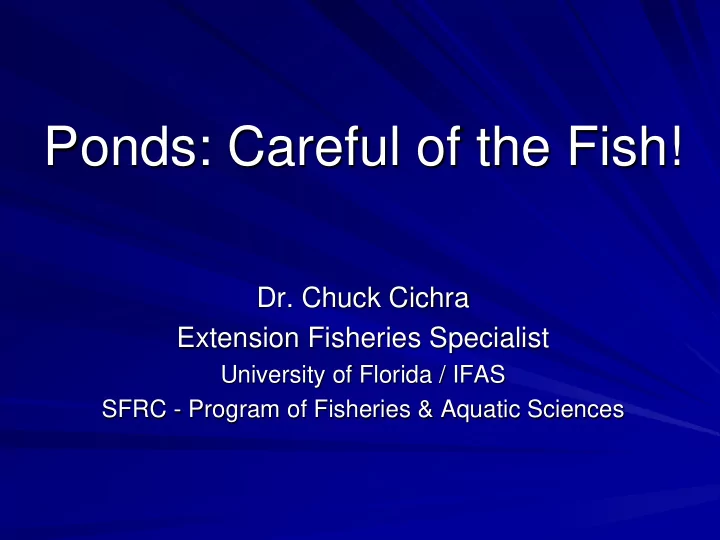

Ponds: Careful of the Fish! Dr. Chuck Cichra Extension Fisheries Specialist University of Florida / IFAS SFRC - Program of Fisheries & Aquatic Sciences
All Plants Need Water, Light, and Nutrients
Aquatic Plants are No Different
Algae are simply small plants!
New Ponds are “Clean” Clear Water Few Algae / Plants
Over Time – Ponds Become More Fertile, Plants Become More Abundant Green Water (Algae) Lots of Plants Eutrophication = Enrichment ( increased nutrients – P and N ) of a water body
Unacceptable – Looks Bad!
Where Do the Nutrients Come From????
Natural Phosphate Deposits in Florida (soils)
Well Water is Often Full of Phosphorus
Stormwater Ponds are Built to Catch Storm Runoff / Nutrients (P and N) Lawn fertilizers, leaves, sticks, grass clippings, …
Fish Feed
Livestock and Other Agriculture
Human Waste
Nutrients = Plants Macrophytes ( large plants ) Algae ( phytoplankton )
Water clarity and algae Secchi Disk Water clarity decreases as algae (phytoplankton) increases
Amount of Chlorophyll (algae) in the Water is Closely Related to the Amount of Nitrogen and Phosphorus in the Water Data from 60 Florida Lakes
Fertilization – Purposeful Addition of Nutrients to the Water
Fish blocknet data on 60 Florida lakes 250 200 Blocknet Total Fish (kg/ha) 150 100 50 0 Oligotrophic Mesotrophic Eutrophic Hypereutrophic Trophic State (chlorophyll)
Bird survey data from 48 Florida lakes 200 2 ) Bird Abundance (kg/km 150 100 50 0 Oligotrophic Mesotrophic Eutrophic Hypereutrophic Trophic State (Chlorophyll)
Alligator survey data from 60 Florida lakes 50 40 Observed Alligators/km 30 20 10 0 Oligotrophic Mesotrophic Eutrophic Hypereutrophic Trophic State
So, is Eutrophication “Good” or “Bad” ? A ‘natural’ process Can be ‘spend up’ by humans Results in more plants (large / small) and more animals (inverts, fish, birds, etc.) “Good” or “Bad” depends on our personal perspective / view / goal So, “eutrophication” does not mean that a water body is “dead”!
Water vs Macrophytes Greener - less macrophytes Browner (more color) – less macrophytes More clay and suspended bottom sediments - less macrophytes Plants grow to ~1.7 x the Secchi depth Pond construction / Pond dyes
Macrophytes vs Water More macrophytes – less planktonic algae More macrophytes – less suspended matter Macrophytes affect fish community composi tion
Role of Plants as Fish Habitat? Spawning areas Refuge - cover from predators (fish/birds) Refuge - places for predators to “hold” Food / Feeding areas - Fish may eat the plants directly - Many fish can shift their diets from invertebrates that live on plants to those that live in/on the bottom
Can get shifts in fish community composition (plants algae) Warmouth Gizzard Shad Golden Shiner Blue Tilapia
How Many Plants are Needed? Just Enough! Too many!
So if nutrients don’t kill fish, then what causes fish kills?
A lot of People Believe that Toxins Cause Most Fish Kills
Aquatic Herbicide Toxicity (ppm) Expected Bluegill application rate 96-hr LC-50 Copper – low alkalinity 0.5-1.0 0.88 Endothall alkylamine salt 0.1-1.0 0.94 Copper – high alkalinity 0.5-1.0 7.3 2,4-D 0.5-3.0 168 Diquat 0.12-0.37 245 Endothall dipotassium salt 1.0-3.0 343 Fluridone 0.01-0.09 891 Carfentrizone 1.0-3.0 >1000 Glyphosate NA >1000 Imazapyr NA >1000
Humans Can Directly Cause Fish Kills However, Most Fish Kills are “Natural” Generally due to Low Dissolved Oxygen in the Water
Sources of Oxygen: Diffusion Agitation Photosynthesis
Diffusion of Oxygen Into Water
Response of Fish to Low Oxygen
Agitation Speeds up Diffusion of Oxygen into Water
Natural Agitation = Waves
Man-Made Agitation = Aerators
( 85-95% of oxygen in ponds / lakes )
So how much oxygen is enough?
Sometimes the Algae Die! Lots of Dead Fish!
Too Many Floating Plants can Block Sunlight and Prevent Pond Mixing
Effect of Submersed Plants on the Vertical Distribution of Oxygen in the Water Column
Density Differences due to Water Temperature Differences Prevent Mixing
Cross-sections of Deep and Shallow Lakes “Bad” Water: High H 2 S, Low Dissolved Oxygen, High CO 2 , High BOD
Summer Thunderstorm! Pond turnover – water is ‘turbid’
So, How do we use this Information in Aquatic Plant Management?
Algae - Should We Spray? How Much? -- Watch the Weather! Education – If you kill the plants, the nutrients are still there!
Submersed Plants – Spray Portion of Plants, Herbicide Selection, Time of Year, Aerate -- Weather
Floating Plants - Use of Herbicides: Partial Treatments, Herbicide Selection, Weather – Bite the Bullet and Spray?
Floating Plants – Grass Carp: Aerate & Use Herbicides to Improve Efficacy
Shift between large plants and phytoplankton (algae) – be careful! Herbicides Grass Carp Nutrients still in the pond!
Effects of Drought? No Water: No Fish! ( Fish stir up bottom sediments and water is hot )
For more information: UF/IFAS Extension Circulars
Recommend
More recommend